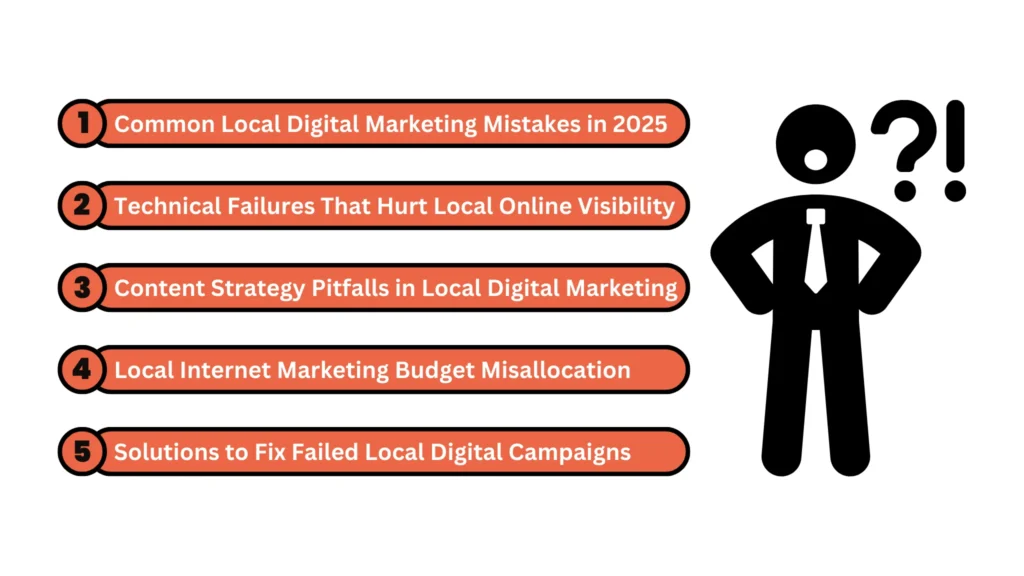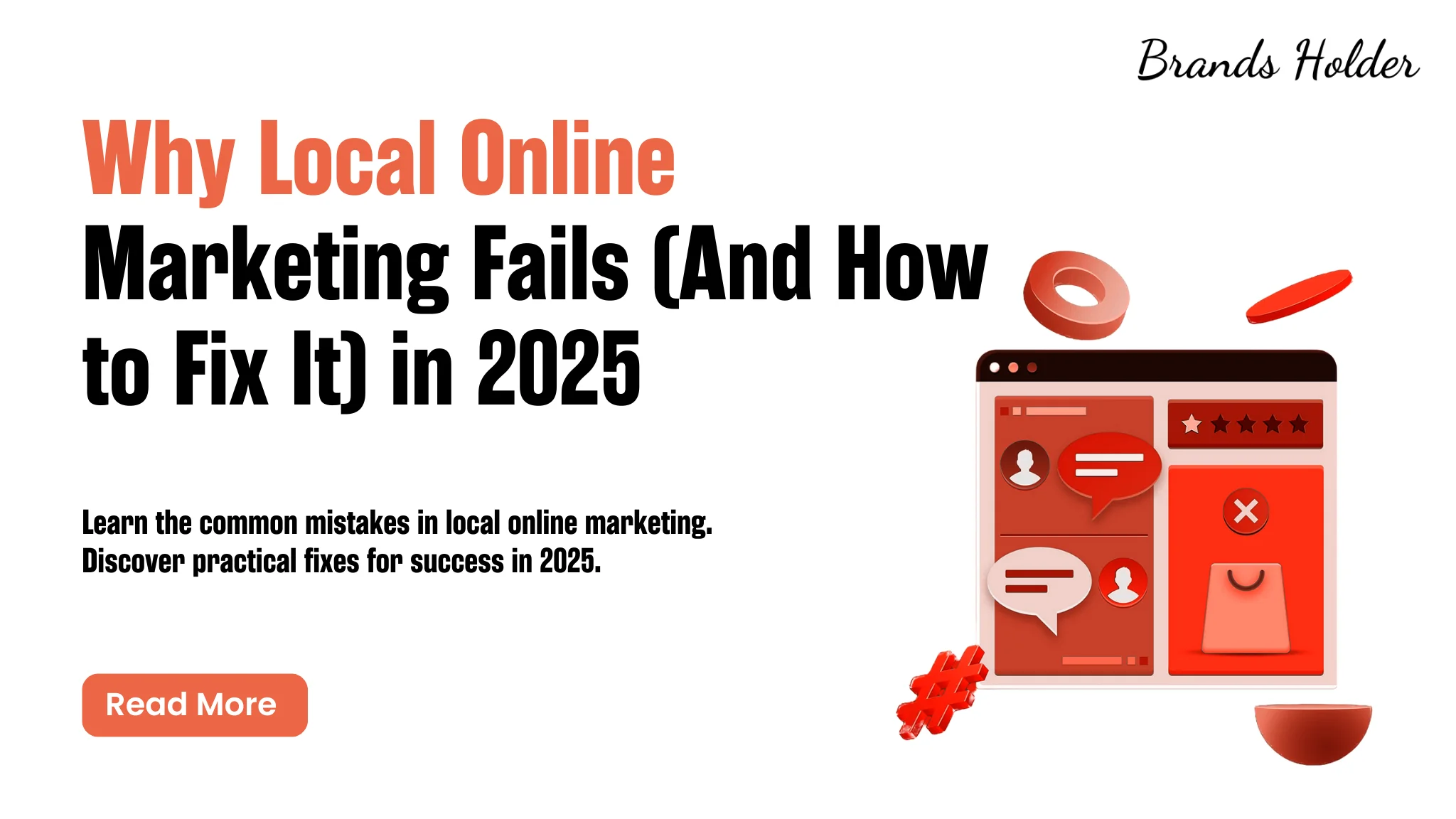85% of consumers research businesses online before making a purchase, yet many local digital marketing efforts don’t reach their full potential. Local searchers are ready to buy – 76% visit a business within 24 hours of their search. However, companies still struggle to attract these motivated customers.
Local digital marketing success demands more than just an online presence. The right strategies must work at the right time. Our deep analysis of failed campaigns and successful turnarounds reveals the critical mistakes that limit businesses. We’ve discovered what works and what doesn’t. This piece will help you avoid common pitfalls and apply proven solutions that will serve you well through 2025 and beyond. You’ll learn to boost your current strategy or start fresh with confidence.
Common Local Digital Marketing Mistakes in 2025

Local businesses don’t deal very well with digital marketing challenges. Search data reveals that 64% of all searches now happen on mobile devices. Three mistakes keep hurting local marketing efforts in 2025.
Ignoring mobile-first optimization
Mobile optimization is the lifeblood of modern marketing since over 50% of global web traffic comes from mobile devices. Businesses that skip mobile-friendly design pay a heavy price – 88% of consumers who look up local businesses on their phones visit or call within 24 hours. Bad mobile experiences show up as:
- Slow loading times on small screens
- Difficult navigation elements
- Missing or broken mobile components
Poor local digital marketing keyword research
Bad local keyword research affects how visible you are to potential customers. Many businesses use generic keywords instead of location-specific terms and miss out on valuable local traffic. 76% of trackable website traffic flows from organic search. This makes proper keyword targeting vital to local digital marketing success.
Inconsistent NAP information across platforms
Name, Address, and Phone number (NAP) consistency is the lifeblood of local online visibility. 93% of consumers get frustrated with wrong information in online directories. 80% of potential customers lose trust in businesses that show different contact details across platforms.
These mistakes create problems beyond just annoying customers. Search engines need accurate, consistent information to rank local businesses. Different NAP details across platforms confuse both search algorithms and potential customers. 70% of marketers say social media engagement relates directly to business growth. This makes these basic mistakes especially pricey for local businesses that want to grow their digital presence.
Technical Failures That Hurt Local Online Visibility
Technical problems can seriously affect how visible a business is online. Studies show that websites with technical errors face major barriers to ranking well in local searches. Let’s look at three big technical failures that hurt local online marketing efforts.
Incorrect schema markup implementation
Search engines won’t show rich results when businesses make schema markup mistakes. Most businesses find it hard to get this right at first. They either mark up content users can’t see or use the wrong schema types on their pages. A study shows that businesses can get 25-30% more clicks with the right schema setup. Businesses should take these steps to stay visible:
- Check schema through Google’s Rich Results Test
- Make sure marked-up content matches what users see
- Use specific LocalBusiness schema subtypes
- Keep track of schema performance in the Search Console
Poor website loading speed
Page speed affects user behavior and search rankings directly. Users tend to leave sites 38% more often when pages need five seconds to load. This hits conversion rates hard – just one extra second of loading time can drop conversions by 7%.
Making a website faster needs work on several fronts. Studies prove that better caching, optimized images, and faster servers can make pages load much quicker. Local businesses need their pages to load in under three seconds to compete well in local search results.
Missing local-specific meta-data
Meta-data is vital to local search visibility. Search engines use it as their main tool to understand and sort local business content. Three key meta elements shape local search performance: title tags, description tags, and image tags.
The right meta-data helps search engines find and index local business websites better. Research shows that consistent meta-data makes information easier to find and use. Meta-data should include details about the business location and match its physical address information to work best for local visibility.
Content Strategy Pitfalls in Local Digital Marketing
Businesses still find it hard to create good local content. Research shows they often end up writing basic blog posts that barely anyone reads. Let’s look at three big problems that stop local digital marketing from working.
Generic content not tailored to the local audience
Studies show that content made for specific areas helps build stronger connections and gets more people involved. Many businesses try to create content but miss the target. They write general material that doesn’t connect with their local market. Yes, it is true that successful local content should have:
- Coverage of local events and community projects
- Success stories from the area
- Detailed pages about location-based services
- Value propositions that focus on the community
Lack of Local Authority Signals in Local Digital Marketing
You need more than just an online presence to build local authority. Research points out that link-building ranks among the top competitive factors for local businesses in tough markets. Local companies should focus on getting mentions from trusted sites in their community.
We learned that building local authority comes from real community relationships. Studies show brands naturally gain authority in fields like hospitality and retail. Service-based businesses don’t deal very well with building credibility. All the same, successful local businesses become household names through community involvement and relationship building.
Poor review management strategy
Review management is a vital part of local digital marketing. Data shows that 98% of consumers read online reviews before buying anything. About 46% of customers trust these reviews more than what businesses say about themselves.
Reviews affect more than just reputation. Google looks at five key factors when ranking local businesses based on reviews:
- Review count and credibility
- Review recency and relevance
- Review frequency and consistency
- Overall star rating
- Reviewer authority level
Research tells us that 88% of consumers will visit a business that responds to both good and bad reviews. About 45% choose to work with brands that handle negative feedback well. Bad reviews that go unanswered can change customer decisions for a long time.
Local Digital Marketing Budget Misallocation
Budget allocation makes or breaks local digital marketing success. Studies show that only 33% of businesses feel happy with their marketing program results. Three major budget-related problems cause this widespread disappointment.
Overspending on the wrong channels
Companies often mismanage their marketing budget because they don’t arrange spending with local market needs. Research shows that successful companies take a smart approach. They understand that you don’t need huge budgets to make a big impact locally. The core elements of budget optimization include:
- Analyzing regional differences in customer demographics
- Evaluating purchasing behaviors
- Assessing media consumption habits
- Monitoring channel-specific performance metrics
How inadequate ROI tracking affects local digital marketing
ROI tracking is a vital element because data proves that businesses need to connect marketing activities to financial outcomes. Local businesses find it hard to measure both online and offline conversions properly. Studies show that good ROI tracking should include:
Cost per lead (CPL) analysis helps identify economical lead generation strategies. On top of that, customer lifetime value (CLV) calculations help measure long-term customer relationships and determine if marketing expenses justify customer acquisition costs.
Ignoring high-impact local platforms
Many businesses today miss out on powerful local marketing platforms that could boost their market presence. Research confirms that local SEO works as a powerful tool to increase visibility without big budgets. High-impact platforms deliver better results when businesses concentrate on:
- Online listings management for accurate business information
- Review response systems to involve customers
- Local event marketing opportunities
- Strategic email marketing campaigns
- Community partnership initiatives
Data reveals that proper tracking systems let businesses collect the information they need to assess campaign performance. Marketing experts stress the importance of evaluating both direct costs (advertising, production expenses) and indirect costs (staff time, promotional discounts). Local marketing success depends on regular program audits, feedback reviews, and matching efforts with channel goals.
Solutions to Fix Failed Local Digital Marketing Campaigns
Local digital marketing succeeds when businesses combine data analytics, technological innovation, and genuine community involvement. Companies that use analytical insights see their revenue grow by 40%. This shows how informed decisions can revolutionize local marketing.
Implementing data-driven strategies
Analytical marketing gives businesses a complete view of their customers’ priorities. This helps them make decisions based on facts rather than guesses. The approach goes beyond simple demographics. It combines website analytics, social media interactions, and purchase histories to paint a complete picture of customer behavior.
A successful implementation needs:
- Strategic data collection from multiple sources
- Regular analysis of customer behavior patterns
- Live campaign performance monitoring
- Resource allocation based on proven results
- Continuous optimization of marketing efforts
Utilizing AI for local targeting
AI technology has become more available, letting small enterprises compete effectively. Machine learning algorithms help analyze vast amounts of customer data quickly. Small businesses that use generative AI tools see significant growth – about 40% of them now use these tools.
AI disrupts local marketing in several key ways. These tools help schedule and publish social media posts, manage inventory, and create efficient workflows. AI algorithms understand context in voice searches, which lets businesses optimize their content.
AI integration works exceptionally well in predictive advertising and location-based targeting. Travel pattern analysis powered by AI helps advertisers place mobile ads more strategically by understanding customer routes better.
Building authentic local connections
Genuine community relationships are the lifeblood of successful local marketing. Professional associations of all types provide excellent networking, brand-building, and referral-generation opportunities. Businesses that genuinely participate in their communities often gain more loyal customers and a stronger market presence.
Virtual communities create powerful connection opportunities. Businesses can connect globally while sharing stories and learnings by joining or creating online groups. These platforms help companies show their expertise, build trust, and promote meaningful relationships with local audiences.
Local digital campaigns work best when people feel seen, heard, and valued. Every customer interaction represents a human seeking connection. Companies can build loyal, engaged, and successful communities that propel development in their local markets by focusing on empathy and genuine engagement.
Conclusion
Success in local digital marketing just needs careful attention to detail and smart implementation. Our largest longitudinal study reveals how small oversights can substantially affect local business growth. Technical failures, poor mobile optimization, and budget misallocation might seem overwhelming, but each challenge has a solution.
Our information shows that businesses using AI-powered tools and authentic community engagement strategies get better results. The path to success goes beyond fixing individual issues. You need an all-encompassing approach that blends technical excellence with genuine local connections.
Small adjustments often create big improvements. Your digital presence will grow stronger when you optimize for mobile, fix technical issues, and build authentic local relationships. Local marketing changes all the time. You will achieve long-term success by staying current with best practices and keeping your NAP information consistent across platforms.
Local digital marketing becomes most effective when businesses excel at both technical precision and human connection. Your local business can build a stronger online presence that strikes a chord with your community and accelerates growth by addressing the common pitfalls outlined in this piece.



